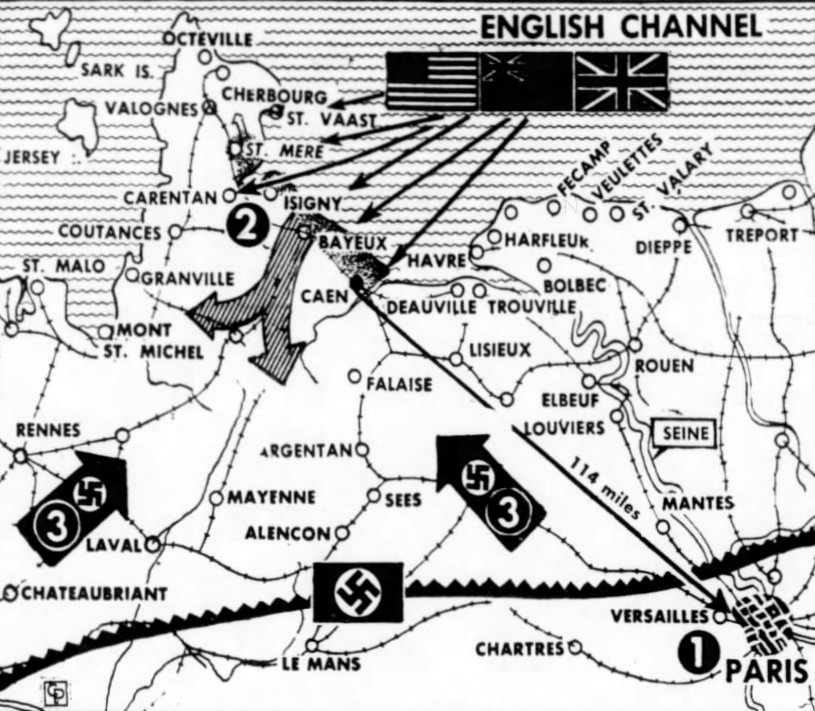Mr. Smith und die Invasion
dr. th. b. Stockholm, 10. Juni –
Welche Stimmungen, Gefühle, Überlegungen beherrschen den Mann auf der Straße in London und Neuyork nun, da das „große Abenteuer,“ wie Winston Churchill von der Landung auf dem europäischen Kontinent sprach, seinen blutigen und über alle Erwartungen verlustreichen Anfang genommen hat? Wie haben Mr. Smith und Mr. Brown reagiert, als am frühen Morgen des 6. Juni der Londoner Nachrichtendienst und die vielen großen und kleinen Sender der Vereinigten Staaten die ersten deutschen Meldungen von dem Beginn der Invasion brachten und erst drei Stunden später das erste amtliche Kommuniqué aus Eisenhowers Hauptquartier kam? Wie denken sie sich den weiteren Verlauf? Sind sie überrascht oder haben sie sich die Invasion genauso vorgestellt, wie sie sich jetzt auf der Halbinsel Cotentin abspielt?
Es sind dies alles Fragen, die von einem neutralen Beobachtungsposten aus schwer und nur zum Teil beantwortet werden können. Versuchen wir trotzdem auch zwischen den Zeilen der uns hier vorliegenden Berichte aus London und New York zu lesen und skizzenhaft ein paar Bilder festzuhalten! Für die feindliche Propagandazentrale kam es von vornherein darauf an, in der englischen und amerikanischen Bevölkerung eine religiöse Massenhysterie zu erwecken, um die ungeheuren Blutopfer des „Unternehmens Eisenhower“ als notwendig, unvermeidlich und gerechtfertigt erscheinen zu lassen. Es scheint das unter den leicht erregbaren Yankees leichter gelungen zu sein als unter den Briten, obwohl auch bei ihnen eine zunehmende Neigung zu Hysterie und Massenwahn festzustellen ist.
„Feierliche Szenen,“ so heißt es in einem Bericht aus Neuyork, „spielten sich im ganzen Lande ab, von Neuyorks stattlichen Kathedralen bis zu den kleinen und ärmlichen Bethäusern im Negerviertel Harlem und den einfachen Hauskirchen in unzähligen kleinen Dörfern. Eine Woge von Religiosität war erweckt.“ Wie wenig echt aber diese Erweckung war, zeigt ein Blick auf die amerikanische Presse. Die Daily News brachte einen Leitartikel mit der Überschrift „Vater unser,“ New York Times, Daily Mirror druckten Gebete ab, die Kinovorstellungen begannen mit Gebeten, Roosevelt wurde im Gebet versunken gezeigt, während die amerikanische Flagge im Dunkel von Scheinwerfern angestrahlt, im künstlichen Wind flatterte, die großen Geschäfte in Manhattan schlossen, „um es dem Personal zu ermöglichen, an den Abendgottesdiensten teilzunehmen.“
Nicht viel anders wirkte sich dieser religiöse Rummel – man muß dieses harte Wort gebrauchen – in London aus. Sehr viel schneller wurde ja auch die englische Bevölkerung Zeuge der außergewöhnlich hohen Verluste, die bereits die ersten vierundzwanzig Stunden kosteten. Die Bewohner der Küstengebiete sahen am Mittwoch Kolonnen von Autos den Küstenstädten zustreben, von Londoner Privatärzten gesteuert, die in aller Eile aufgeboten werden mußten, um ihre Arbeit in provisorisch eingerichteten Lazaretten aufzunehmen. Seit Mittwoch früh lief dann ein Lazarettzug nach dem andern in den Londoner Bahnhöfen ein, die polizeilich gesperrt wurden, um die Verbreitung von Nachrichten unter der Bevölkerung möglichst zu verhindern.
Zweifellos kann man den Berichten glauben, die von einem feierlichen Ernst sprechen, der sich am Dienstag über alles gebreitet habe. Auch Mr. Smith wird gewußt haben, was für England mit dem „Unternehmen Eisenhower“ auf dem Spiele steht. Plötzlich war London von Uniformen leergefegt.
Für einen Fremden dürften es kaum mehr als die Sperrballons, die Ruinen und die Militärautos, die in rasender Fahrt die Straßen durchsausen, sein, die den Eindruck erwecken, daß er die Hauptstadt eines Empire erlebt, in der gleichzeitig die Drähte der Kriegführung der Westmächte zusammenlaufen.
Als einen „Kreuzzug,“ als einen „Kampf zur Befreiung Europas“ versuchten die Zeitungen den Invasionsversuch zu stempeln. Für Mr. Smith ist es doch vor allem der Kampf um England, wobei im Unterbewußtsein immer wieder der Wunsch durchdringt, endlich einmal die ärgerlichen amerikanischen Besatzungstruppen Bus dem Straßenbild und aus den Gaststätten und Kinos verschwinden zu sehen.
Die größte Überraschung dürfte es wohl gewesen sein, daß es Eisenhower nicht gelang, den deutschen Atlantikwall von der See her und durch Luftlandetruppen vom Lande her in einem Umfang aufzubrechen, daß dem General Montgomery ein genügend breites und tiefes Aufmarschgebiet zur Entfaltung weit angelegter Operationen zur Verfügung stand. Es kann kaum in dem Invasionsfahrplan vorgesehen gewesen sein, daß Eisenhower in die gewonnenen Brückenköpfe nun weitere Kräfte hineinpumpen muß, Kräfte, die wahrscheinlich für andere Unternehmen angesetzt waren, um dieses Aufmarschgebiet doch noch zu gewinnen. Wie weit solche Überlegungen, die in militärischen Kreisen sicher sehr ernsthaft angestellt werden, dem Manne auf der Straße geläufig sind, sei dahingestellt. Er wird mit den widersprechendsten Nachrichten überschüttet, auf seine schwachen Nerven nimmt das Pressehauptquartier Eisenhowers keine Rücksicht.
Denn dieses will nur folgendes erreichen: Vor allem eine Siegespsychose schaffen, um bei dem bolschewistischen Verbündeten den Eindruck zu erwecken, daß alles zum Besten stünde, um eine möglichst frühzeitige Offensive an der Ostfront zur Entlastung des eigenen Unternehmens herauszulocken, zweitens für die politische Offensive gegen die Neutralen agitatorische Unterlagen zu schaffen und drittens auf der Gegenseite Dementis zu erzielen, die zur eigenen Unterrichtung dienen sollen. Die Zusammenballung von Hunderten von Journalisten im Londoner Informationsministerium tut ein Übriges, um die britische Hauptstadt zu einem Wespennest von Meldungen und Gerüchten zu machen. Vor diesem bedrohlichen Wespennest steht Mr Smith und wundert sich. Er wird sich noch mehr wundern.


